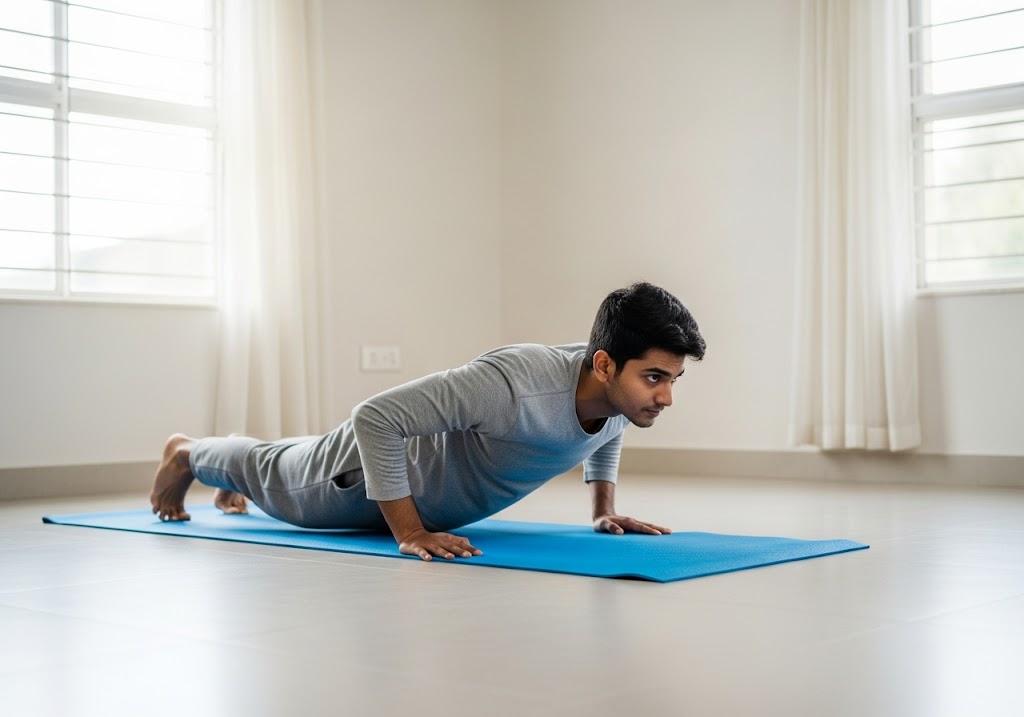How many planks should I do a day? Perform 3-4 sets of 45-90 second planks daily, adjusting hold times based on your fitness level and focusing on consistent practice with perfect form rather than excessive volume. Key factors for how many planks should I do a day are: Fitness level, goals (abs, weight loss, strength), current core strength, time availability, plank variations, hold duration, recovery needs, and progressive overload for optimal results.
Want to know exactly how many planks should I do a day for maximum core strength and visible abs? This comprehensive plan provides specific daily plank recommendations based on your fitness level and goals. Whether you’re a beginner wondering how many times should I do planks a day or an advanced athlete looking to optimize your routine, this complete training plan covers everything you need for effective core development.
Table of Contents
How Many Planks Should I Do a Day Based on Goals?
Your specific fitness goals determine the optimal answer to how many planks should I do a day. Different objectives require different training approaches, volumes, and progressions for maximum effectiveness. This goal-based approach ensures you get the most appropriate plank routine for your individual needs.
| Goal | Daily Sets | Hold Time | Weekly Frequency | Additional Notes |
|---|---|---|---|---|
| General Fitness | 3-4 | 45-60 seconds | 5-6 days | Focus on consistency |
| Athletic Performance | 4-6 | 30-90 seconds | 6-7 days | Include variations |
| Rehabilitation | 2-3 | 15-45 seconds | 4-5 days | Prioritize form |
| Maximum Strength | 5-6 | 60+ seconds | 6-7 days | Progressive overload |
| Weight Loss Support | 3-5 | 45-75 seconds | 6-7 days | Combine with cardio |
| Visible Abs | 4-5 | 60-90 seconds | 6-7 days | Low body fat required |
1. General Fitness
For general fitness, perform 3-4 sets of 45-60 second planks daily to build core strength and stability. This volume provides excellent fitness benefits without excessive time commitment or recovery demands, making it perfect for maintaining overall health and functional strength.
2. Athletic Performance
Athletes may benefit from 4-6 sets daily with varied plank types to address sport-specific stability needs. Include dynamic planks and single-limb variations for enhanced performance transfer, focusing on movements that directly support your specific athletic demands and requirements.
3. Rehabilitation
Those recovering from injury should start with shorter holds and fewer sets, progressing based on physical therapy guidance. Quality movement patterns take priority over training volume during rehabilitation phases, ensuring safe recovery while rebuilding core strength and stability gradually.
4. Maximum Strength
Strength-focused individuals can perform 5-6 sets daily with progressive overload through increased hold times, added resistance, or advanced variations. This approach demands higher training volumes and systematic progression for continued strength development and muscle building over time.
5. Weight Loss Support
For weight loss support, combine 3-5 sets of planks daily with cardiovascular exercise and proper nutrition. While planks don’t burn massive calories directly, they build muscle that increases metabolic rate, supporting overall fat loss when combined with comprehensive fitness programming.
6. Visible Abs
Achieving visible abs requires 4-5 sets of 60-90 second planks daily combined with low body fat through proper nutrition. Remember that planks strengthen abdominal muscles, but visible definition requires reducing body fat through caloric deficit and comprehensive exercise programming for optimal results.
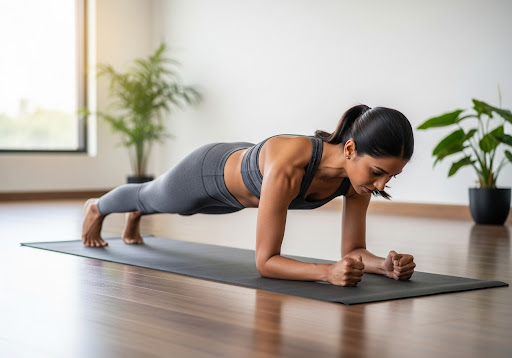
Why You Should Start Doing Planks?
Planks represent one of the most effective bodyweight exercises for building core strength, improving posture, and developing total-body stability. Understanding how many planks should I do a day begins with recognizing the incredible benefits this simple yet challenging exercise provides for overall fitness and functional movement.
- Complete Core Activation: Planks engage all major core muscles including rectus abdominis, obliques, and transverse abdominis simultaneously
- Improved Posture: Regular plank practice strengthens postural muscles that combat forward head position and rounded shoulders
- Enhanced Stability: Develops deep stabilizing muscles essential for balance, coordination, and injury prevention
- Functional Strength: Builds core strength that transfers to daily activities like lifting, carrying, and maintaining proper body alignment
- Minimal Equipment Needed: Requires no equipment or gym membership, making it accessible for home workouts anywhere
- Scalable Difficulty: Can be modified for beginners or advanced practitioners through various progressions and holds
- Time Efficient: Provides maximum core training benefits in minimal time, perfect for busy schedules
- Full-Body Engagement: Activates muscles throughout the entire body, not just the core region
For those new to bodyweight training, exploring bodyweight exercises for beginners provides excellent foundation movements that complement plank training.
What Muscles Do Planks Work?
Understanding which muscles planks work helps determine how many planks should I do a day for specific muscle development goals. Planks activate multiple muscle groups simultaneously, making them incredibly efficient for total-body strengthening and core development.
| Muscle Group | Primary Function | Plank Role | Development Benefits |
|---|---|---|---|
| Rectus Abdominis | Trunk flexion | Stabilization | Visible abs, core strength |
| Obliques | Rotation, side bending | Anti-rotation | Waist definition, stability |
| Transverse Abdominis | Deep core support | Internal pressure | Core stability, back health |
| Erector Spinae | Spinal extension | Posture maintenance | Back strength, posture |
| Glutes | Hip extension | Posterior stability | Hip strength, alignment |
| Shoulders | Arm support | Weight bearing | Shoulder stability, endurance |
| Legs | Lower body support | Isometric hold | Leg endurance, alignment |
The comprehensive muscle activation explains why determining how many times should I do planks a day depends on your overall fitness goals rather than just core strength alone. This full-body engagement makes planks incredibly valuable for complete functional fitness development.
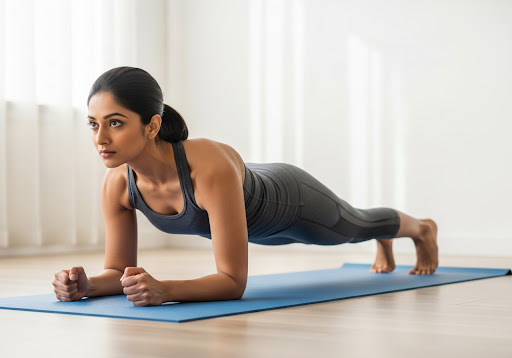
How to Do a Plank?
Proper plank form is essential before determining how many planks should I do in a day for optimal results. Perfect technique ensures maximum muscle activation while preventing injury and building the foundation for progressive plank training.
Basic Plank Setup
Start in a push-up position with forearms on the ground and elbows directly under your shoulders. Maintain a straight line from head to heels, engaging your core muscles to prevent sagging or piking. Keep your neck neutral and breathe steadily throughout the hold.
Key Form Points
Focus on maintaining proper alignment by engaging your glutes, keeping your hips level, and avoiding dropping your lower back. Press your forearms firmly into the ground while maintaining tension throughout your entire body for maximum effectiveness.
Common Mistakes to Avoid
Avoid letting your hips sag or pike up, holding your breath, or allowing your shoulders to roll forward. These mistakes reduce effectiveness and can lead to strain or injury during extended plank practice.
For detailed technique instruction, how to do plank exercise provides comprehensive form guidance for perfect plank execution.
How Many Planks Should I Do a Day for Beginners?
For beginners wondering how many times a day should I do planks, start with shorter holds and fewer repetitions to build basic core strength and endurance. Progressive overload through increased hold times proves more effective than excessive daily volume initially.
| Week | Hold Time | Sets | Total Time | Rest Between | Focus |
|---|---|---|---|---|---|
| 1-2 | 15-30 seconds | 3 | 45-90 seconds | 30 seconds | Form mastery |
| 3-4 | 30-45 seconds | 3 | 90-135 seconds | 30 seconds | Endurance building |
| 5-6 | 45-60 seconds | 3 | 135-180 seconds | 45 seconds | Strength development |
| 7-8 | 60+ seconds | 3-4 | 180+ seconds | 45 seconds | Progressive challenge |
Beginners should focus on quality over quantity when determining how many times should I do plank in a day. Three sets of properly executed planks with shorter holds builds better foundation than longer holds with poor form.
Starting with proper warm-up preparation using warm up exercises for beginners ensures safe and effective plank training sessions.
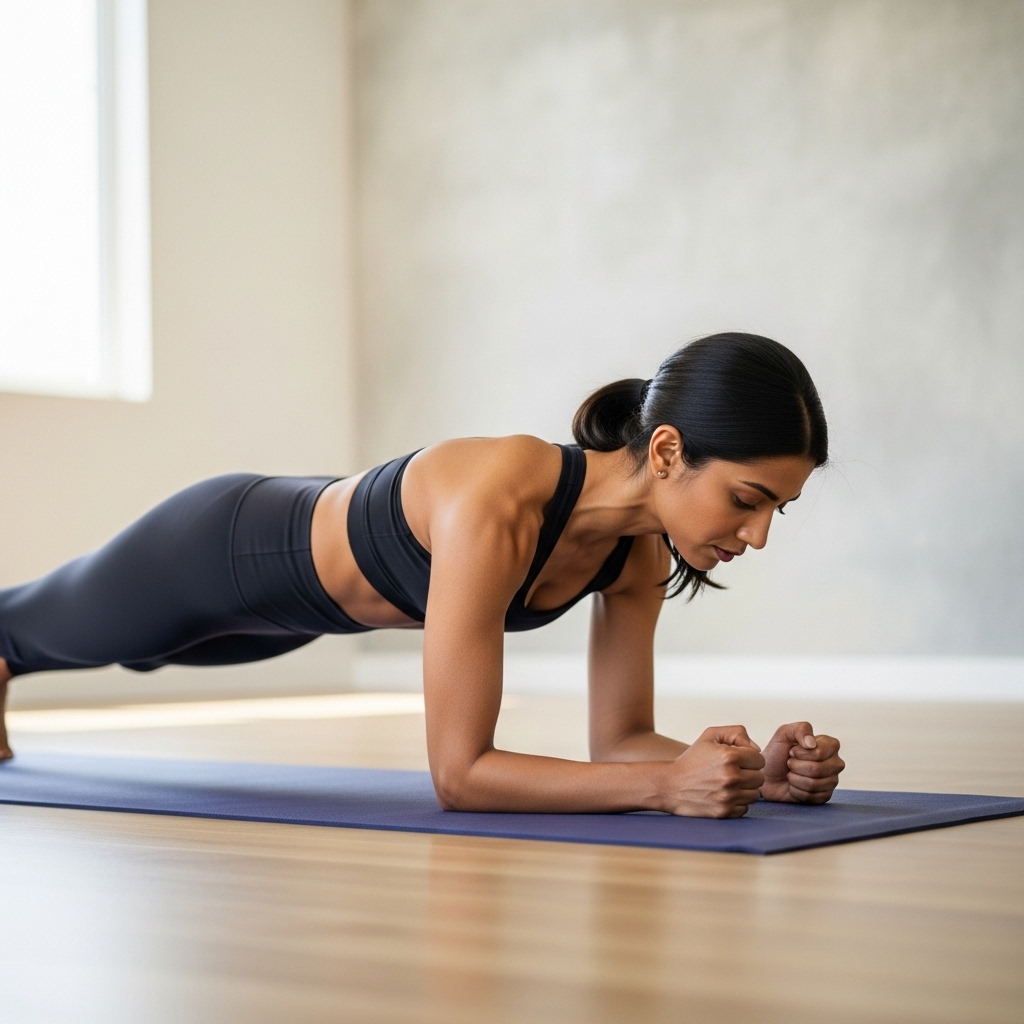
How Many Planks Should I Do a Day to Get Abs?
The question of how many planks should I do a day to get abs depends on your current body fat percentage and overall fitness routine. While planks strengthen abdominal muscles, visible abs require low body fat achieved through proper nutrition and comprehensive exercise programming.
Daily Plank Protocol for Abs
Perform 4-6 plank sets daily with holds ranging from 45 seconds to 2 minutes based on your strength level. Focus on progressive overload by gradually increasing hold times rather than dramatically increasing daily volume for optimal muscle development.
Supporting Exercises
Combine planks with other core exercises and full-body movements for complete abdominal development. Planks alone cannot create visible abs without addressing body fat through proper nutrition and cardiovascular exercise integration.
Timeline Expectations
Visible abs typically require 8-16 weeks of consistent training and nutrition depending on starting body fat percentage. Focus on strength gains and hold time improvements rather than expecting immediate visual changes.
For comprehensive core development, calisthenics ab workout provides additional exercises that complement daily plank practice.
How Many Planks Should I Do a Day for Weight Loss?
When considering how many planks should I do a day for weight loss, understand that planks primarily build muscle rather than burn significant calories. However, they support weight loss through increased muscle mass and improved core strength for better exercise performance.
Planks burn approximately 2-5 calories per minute depending on body weight and hold intensity. While this calorie burn seems minimal, the muscle-building benefits increase metabolic rate over time, supporting long-term weight management goals effectively.
| Body Weight | Calories per Minute | 5-Minute Session | Daily Benefit |
|---|---|---|---|
| 125 lbs | 2-3 calories | 10-15 calories | Muscle building |
| 155 lbs | 3-4 calories | 15-20 calories | Metabolic boost |
| 185 lbs | 4-5 calories | 20-25 calories | Core strength |
For weight loss, combine daily planks with cardiovascular exercise and proper nutrition rather than relying solely on planks for calorie burning. The question of how many times should I do planks a day for weight loss should focus on consistency rather than excessive volume.
Understanding exercise timing can optimize results, so exploring is it better to do cardio before or after weights helps structure complete workout programs.
How Many Planks Should I Do a Week?
Weekly plank frequency depends on your fitness level and recovery capacity when determining how many planks should I do a day across seven days. Most people benefit from daily plank practice with varying intensities rather than concentrated high-volume sessions.
Beginner Weekly Schedule
Start with 4-5 days per week, allowing rest days for recovery and adaptation. Focus on building consistency and proper form rather than maximum daily volume during the initial weeks of training.
Intermediate Weekly Schedule
Progress to 5-6 days per week with varying plank types and hold times. Include different plank variations to challenge muscles from multiple angles while preventing adaptation plateaus.
Advanced Weekly Schedule
Advanced practitioners can perform planks daily with strategic variation in intensity, duration, and exercise selection. Monitor recovery and performance to prevent overuse and maintain progressive improvements.
For comprehensive bodyweight training that includes daily planks, calisthenics at home no equipment provides complete workout routines.

How Many Sets of Planks Should You Do?
Determining how many sets of planks should I do relates directly to how many planks should I do a day based on your current strength level and time availability. Most people achieve optimal results with 3-5 sets daily rather than single extended holds.
Set and Rep Schemes
Three to four sets of 30-90 second holds provide better training stimulus than single maximum-effort holds. This approach allows for consistent quality and progressive overload through increased hold times or additional sets.
Rest Periods
Rest 30-60 seconds between plank sets to maintain form quality and training intensity. Adequate rest ensures proper muscle activation and prevents compensation patterns that reduce exercise effectiveness.
Progressive Overload
Increase hold times by 5-10 seconds weekly or add additional sets when current volume becomes manageable. This systematic progression ensures continued strength gains and prevents training plateaus.
How Many Side Planks Should You Do a Day?
Side planks complement regular planks by targeting obliques and lateral core stability. When planning how many side planks should I do a day, include them 3-4 times weekly as part of your total daily plank routine.
| Experience Level | Side Plank Hold | Sets Each Side | Weekly Frequency |
|---|---|---|---|
| Beginner | 15-30 seconds | 2-3 | 3-4 days |
| Intermediate | 30-60 seconds | 3-4 | 4-5 days |
| Advanced | 60+ seconds | 4-5 | 5-6 days |
Side planks require greater stability and strength than regular planks, so progress gradually and maintain perfect form throughout each hold. Quality movement patterns are more important than extended hold times initially.
For unilateral training that complements side planks, unilateral exercises provides additional single-side strengthening movements.
How Long Should You Hold a Plank?
Plank hold duration directly impacts how many planks should I do a day since longer holds reduce the total number of sets needed. Optimal hold times balance muscle building stimulus with sustainable daily practice for long-term progress.
Beginner Hold Times
Start with 15-30 second holds focusing on perfect form and breathing control. Gradually increase hold times by 5-10 seconds weekly as strength and endurance improve through consistent practice.
Intermediate Hold Times
Progress to 45-90 second holds while maintaining perfect form throughout the entire duration. This range provides excellent muscle building stimulus while remaining achievable for most intermediate practitioners.
Advanced Hold Times
Advanced practitioners can hold planks for 2+ minutes, though diminishing returns occur beyond 90 seconds for most people. Focus on plank variations rather than extremely long holds for continued progression.
Optimal Range
Most people achieve best results with 45-90 second holds performed for 3-4 sets daily. This duration maximizes muscle activation while allowing for consistent daily practice and progressive overload.
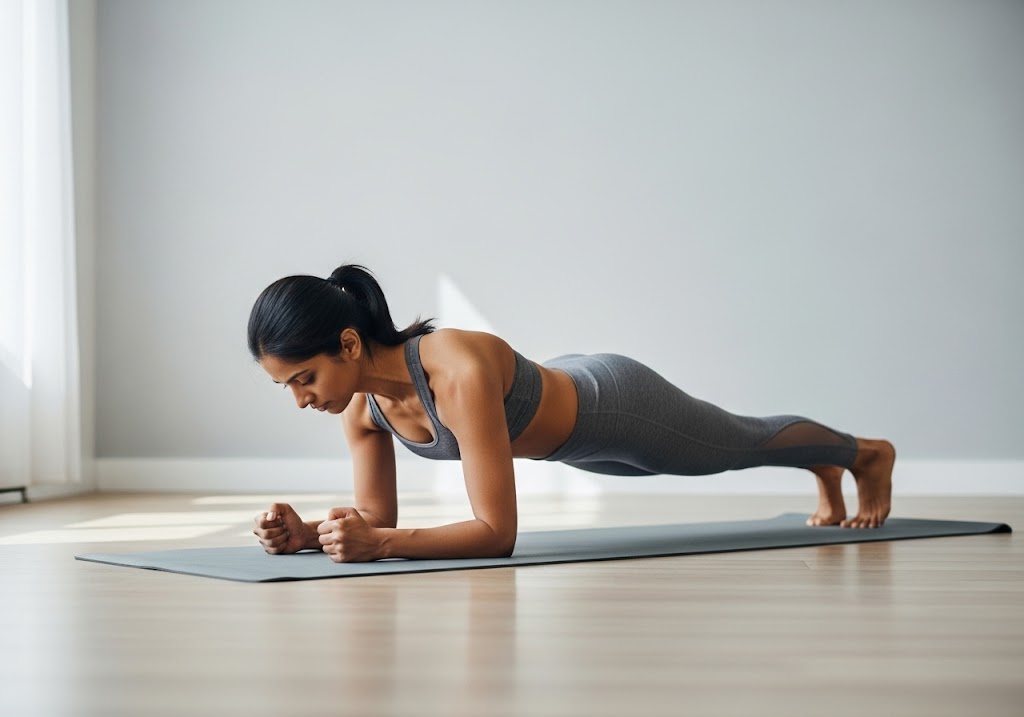
Do Planks Burn Belly Fat?
The question “do planks burn belly fat” is common when determining how many planks should I do a day for fat loss. While planks strengthen abdominal muscles, they don’t specifically burn belly fat since spot reduction is physiologically impossible.
Planks contribute to overall calorie expenditure and muscle building, which supports fat loss when combined with proper nutrition and cardiovascular exercise. The muscle building benefits increase metabolic rate, helping burn more calories throughout the day.
For effective fat loss, combine daily planks with comprehensive nutrition strategies. Exploring intermittent fasting plan provides structured approaches to nutrition for body composition goals.
Total-body fat loss through caloric deficit reveals abdominal muscles strengthened by consistent plank practice. This combination approach proves more effective than planks alone for achieving visible abs and reduced belly fat.
Types of Planks
Understanding different plank variations helps answer how many times should I do planks a day by providing exercise variety and progressive challenges. Different plank types target muscles from various angles while preventing adaptation and boredom.
Standard Plank Variations
Basic forearm planks, high planks, and side planks form the foundation of plank training. Master these fundamental positions before progressing to advanced variations for safe and effective development.
| Plank Type | Difficulty | Primary Target | Hold Time |
|---|---|---|---|
| Forearm Plank | Beginner | Full core | 30-90 seconds |
| High Plank | Beginner | Core, shoulders | 30-90 seconds |
| Side Plank | Intermediate | Obliques | 30-60 seconds |
| Reverse Plank | Intermediate | Posterior chain | 20-45 seconds |
| Plank Up-Downs | Advanced | Dynamic core | 30-60 seconds |
| Single-Arm Plank | Advanced | Anti-rotation | 15-30 seconds |
Dynamic Plank Variations
Moving planks like plank-ups, mountain climbers, and plank jacks add cardiovascular benefits while maintaining core strengthening. These variations increase calorie burn and training variety.
Advanced Progressions
Single-limb planks, weighted planks, and unstable surface planks provide advanced challenges for experienced practitioners. Progress to these variations only after mastering basic plank forms.
For dynamic movement patterns that complement plank training, jumping jacks exercise benefits provides cardiovascular exercises that enhance total fitness.
Can You Get in Shape with Planks Alone?
While planks provide excellent core strengthening, getting completely “in shape” requires comprehensive fitness addressing cardiovascular health, muscular strength, flexibility, and body composition. The question of how many planks should I do a day must be part of a broader fitness strategy.
Planks excel at core strengthening, posture improvement, and stability development but lack cardiovascular training and complete muscular development. They serve as an excellent component of comprehensive fitness programs rather than standalone solutions.
For complete fitness development, combine daily planks with cardiovascular exercise, strength training, and flexibility work. This balanced approach addresses all aspects of physical fitness for optimal health and performance outcomes.
Exploring full body calisthenics workout provides comprehensive bodyweight routines that include planks within complete fitness programs.
How Many Planks Should I Do a Day Based on Goals?
Your specific fitness goals determine the optimal answer to how many planks should I do a day. Different objectives require different training approaches, volumes, and progressions for maximum effectiveness.
For General Fitness
Perform 3-4 sets of 45-60 second planks daily for general core strength and stability. This volume provides excellent fitness benefits without excessive time commitment or recovery demands.
For Athletic Performance
Athletes may benefit from 4-6 sets daily with varied plank types to address sport-specific stability needs. Include dynamic planks and single-limb variations for enhanced performance transfer.
For Rehabilitation
Those recovering from injury should start with shorter holds and fewer sets, progressing based on physical therapy guidance. Quality movement patterns take priority over training volume during rehabilitation phases.
For Maximum Strength
Strength-focused individuals can perform 5-6 sets daily with progressive overload through increased hold times, added resistance, or advanced variations for continued strength development.
Daily Plank Routine Examples
These sample routines answer how many times a day should I do planks based on different experience levels and time availability. Adjust volumes and intensities based on individual capacity and goals.
5-Minute Morning Routine
Perfect for busy schedules, this routine includes 3 sets of 45-second planks with 30-second rest periods. Consistent daily practice builds core strength without significant time investment requirements.
10-Minute Complete Core Routine
Includes standard planks, side planks, and one dynamic variation for comprehensive core development. This routine provides excellent variety while maintaining focus on fundamental plank movements.
15-Minute Advanced Challenge
Combines multiple plank variations with progressive holds and advanced progressions. Suitable for experienced practitioners seeking maximum core development and training challenge.
For those wondering about training with muscle soreness, should you exercise with sore muscles provides guidance on maintaining daily exercise routines.
Plank Progression Timeline
Understanding realistic progression helps set appropriate expectations when determining how many planks should I do a day over time. Consistent daily practice yields steady improvements in strength, endurance, and hold times. This timeline provides structured progression for sustainable long-term development and continued improvement.
| Timeline | Hold Duration | Sets | Focus Area | Key Milestones |
|---|---|---|---|---|
| Week 1-2 | 15-30 seconds | 2-3 | Form mastery | Perfect alignment |
| Week 3-4 | 30-45 seconds | 3 | Basic endurance | Steady breathing |
| Month 2 | 45-75 seconds | 3-4 | Strength building | Add side planks |
| Month 3 | 60-90 seconds | 3-4 | Advanced stability | Dynamic variations |
| Month 4+ | 90+ seconds | 4-5 | Specialized goals | Advanced progressions |
Recovery and Rest Considerations after Planks
Determining how many times should I do plank in a day requires considering recovery needs and training frequency after each session. While planks can be performed daily due to their isometric nature, strategic rest and recovery optimize long-term progress and prevent overuse injuries or performance decline.
Most people can perform planks daily with relatively low muscle damage compared to dynamic exercises. However, listen to your body and include rest days if experiencing excessive fatigue or form deterioration. Active recovery days might include gentler movements or mobility work rather than complete rest for continued adaptation.
For recovery optimization, understanding cold shower vs hot shower benefits can enhance post-workout recovery protocols.
Common Mistakes in Daily Plank Practice
Avoiding common mistakes ensures optimal results when implementing daily plank routines. These errors often limit progress and can lead to injury or frustration with plank training.
- Poor Form: Allowing hips to sag or pike up reduces effectiveness and increases injury risk during extended holds
- Excessive Volume: Doing too many planks daily can lead to overuse and plateau rather than continued improvement
- Inconsistent Practice: Sporadic plank training prevents adaptation and strength building that comes with consistent daily practice
- Ignoring Progressions: Sticking to the same plank type and duration prevents continued challenge and muscle development
- Breath Holding: Holding breath during planks reduces oxygen delivery and limits hold times unnecessarily
- Rushing Through Sets: Moving too quickly between sets without adequate rest compromises form and training quality
For those interested in mind-body approaches that complement plank training, somatic pilates provides movement awareness techniques.
Nutrition Support for Daily Plank Training
While planks primarily build strength rather than burn massive calories, proper nutrition supports muscle building and recovery from daily plank practice. Adequate protein intake supports muscle repair and building from consistent training, while proper hydration maintains performance and prevents fatigue during extended holds.
Energy balance affects training capacity and recovery when determining how many planks should I do a day. Maintain adequate caloric intake to support training demands while achieving body composition goals through sustainable nutrition approaches that fuel performance and promote adaptation.
Building Calisthenics Skills Through Daily Planks
Daily plank practice provides excellent foundation for advanced calisthenics skills requiring core strength and stability. Understanding does calisthenics build muscle helps appreciate how planks contribute to overall bodyweight training progression.
Planks develop the core stability essential for advanced movements like handstand push-ups, human flags, and muscle-ups. Consistent daily practice builds the foundation strength needed for these challenging skills.
For those interested in expanding beyond planks, how to start calisthenics provides comprehensive guidance for progressive bodyweight training development.
The isometric strength built through daily planks transfers to dynamic movements and advanced skills. This foundation makes planks valuable for anyone pursuing advanced calisthenics goals.
Integration with Other Exercises
Daily planks work excellently as part of comprehensive fitness routines rather than standalone exercises. Understanding how to integrate planks with other movements maximizes training efficiency and results.
Planks serve as excellent warm-up exercises for more dynamic movements by activating core muscles and establishing proper body alignment. They also work well as finisher exercises to challenge fatigued core muscles at workout completion.
For comprehensive upper body development, calisthenics chest exercises provides movements that complement daily plank practice perfectly.
The stability built through daily planks enhances performance in pulling exercises like calisthenics close grip pull ups and calisthenics wide grip pull ups.
Addressing Individual Limitations
Some people may need modifications when determining how many planks should I do a day based on physical limitations or injuries. Proper modifications ensure safe training while building core strength progressively.
Those with wrist issues can perform planks on forearms rather than hands. Those with lower back problems should focus on shorter holds with perfect form rather than extended durations that may compromise alignment.
Pregnancy requires plank modifications including incline planks or side-lying variations as pregnancy progresses. Consult healthcare providers for appropriate modifications based on individual circumstances.
Age-related considerations might require longer rest periods, shorter holds, or modified positions. The key is consistent practice within individual capacity rather than forcing inappropriate training volumes.
Understanding recovery techniques like what is foam rolling can help address muscle tension that might limit plank performance.
Conclusion
The question of how many planks should I do a day depends on your fitness level, goals, and available time, but most people achieve excellent results with 3-4 sets of 45-90 second holds performed daily. Consistency matters more than excessive volume when building core strength and stability through plank training. Focus on perfect form, progressive overload, and sustainable daily practice rather than maximum effort that leads to burnout. Whether you’re asking how many times should I do planks a day for abs, weight loss, or general fitness, the answer lies in consistent daily practice with gradual progression over time for lasting core strength development.
Want to master the calisthenics handstand and take your skills to the next level? Whether you’re a beginner or pushing advanced skills, ISC – Indian School of Calisthenics offers expert guidance to help you master bodyweight training. Visit us at SRPF Ground, NH8, Goregaon (E), Mumbai – 400065. For class schedules, personalized coaching, or more details, call +91 77159 53218. Train smart, move better, and unlock your back strength with ISC.
How Many Planks Should I Do a Day? – FAQs
Is 1 minute plank everyday enough?
Yes, one minute daily is excellent for maintaining core strength, though 3-4 sets of shorter holds often provide better muscle building results.
Do planks burn belly fat?
Planks strengthen abdominal muscles but don’t specifically burn belly fat; overall fat loss requires caloric deficit through diet and comprehensive exercise.
Is a 3 minute plank hold good?
A 3-minute plank demonstrates excellent core endurance, though most people achieve better results with multiple shorter holds for muscle building.
How many planks should I do a day to get a flat stomach?
Perform 3-4 sets of 45-90 second planks daily combined with proper nutrition and cardio for flat stomach development over time.
Do planks give you abs?
Planks strengthen abdominal muscles, but visible abs require low body fat achieved through proper nutrition and comprehensive exercise programming.
Is 30 second plank a day good?
Thirty seconds daily is good for beginners, though progressing to multiple sets and longer holds provides greater strength development benefits.
Is a 4 minute plank impressive?
Yes, a 4-minute plank demonstrates exceptional core endurance, though shorter holds with perfect form often provide better training stimulus.
How long to plank by age?
Age-specific guidelines: 20s-30s (60-90s), 40s-50s (45-75s), 60+ (30-60s), though individual fitness level matters more than age.
Is a 10 minute plank good?
Ten minutes demonstrates extreme endurance but provides diminishing returns; shorter holds with variations offer better muscle development results.
Do planks reduce waist size?
Planks strengthen core muscles but don’t reduce waist size directly; fat loss through proper nutrition and exercise creates waist reduction.
How to do plank correctly?
Maintain straight line from head to heels, engage core muscles, keep elbows under shoulders, and breathe steadily throughout the hold.
Which exercise is best for a flat tummy?
Combine planks with proper nutrition, cardio, and varied core exercises rather than relying on single exercise for flat stomach development.
Does plank burn belly fat?
Planks burn minimal calories directly but build muscle that increases metabolism, supporting overall fat loss when combined with proper nutrition.
Is a 5 minute plank good?
Five minutes shows excellent endurance but multiple shorter holds with perfect form typically provide better strength and muscle building benefits.
How to get a flat stomach in 2 weeks?
Two weeks allows initial strength gains and reduced bloating through consistent planks, proper nutrition, and comprehensive exercise programming.

